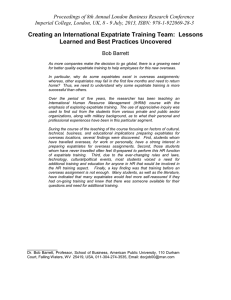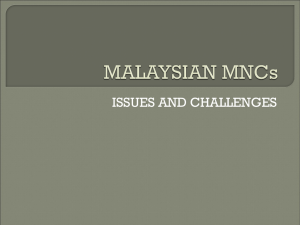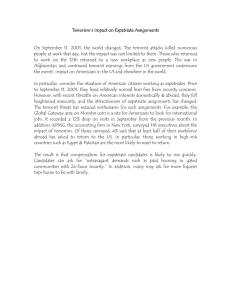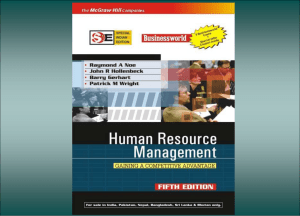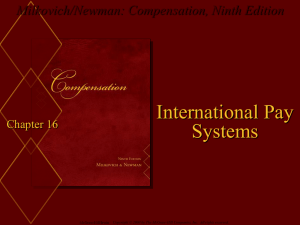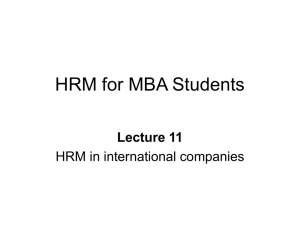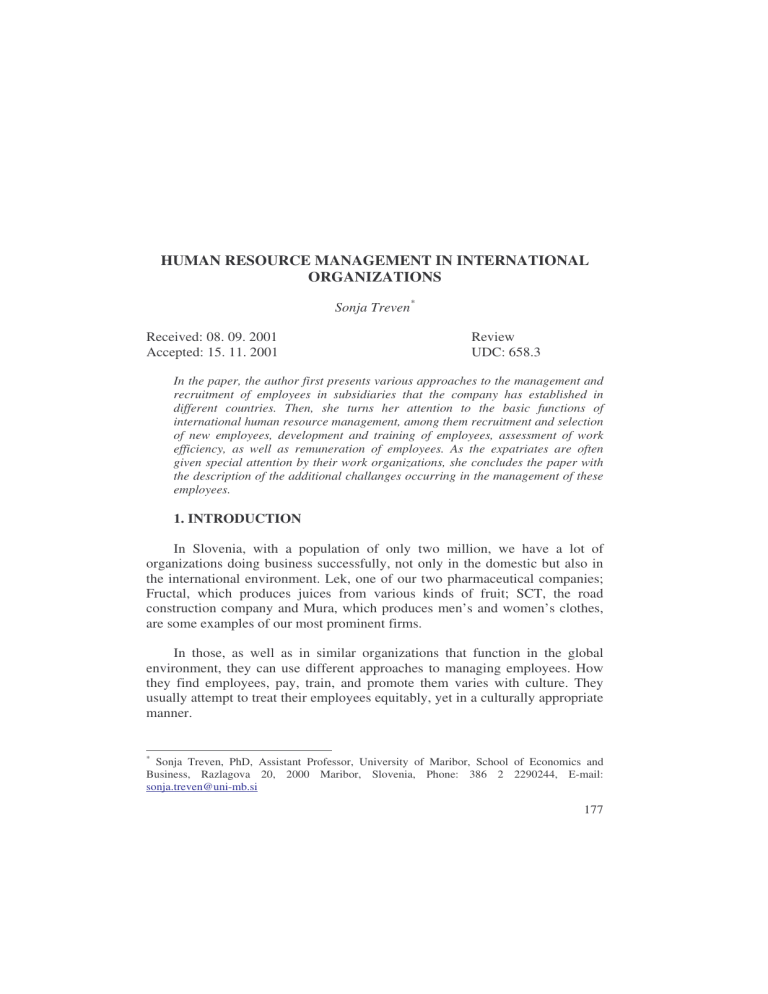
HUMAN RESOURCE MANAGEMENT IN INTERNATIONAL ORGANIZATIONS Sonja Treven* Received: 08. 09. 2001 Accepted: 15. 11. 2001 Review UDC: 658.3 In the paper, the author first presents various approaches to the management and recruitment of employees in subsidiaries that the company has established in different countries. Then, she turns her attention to the basic functions of international human resource management, among them recruitment and selection of new employees, development and training of employees, assessment of work efficiency, as well as remuneration of employees. As the expatriates are often given special attention by their work organizations, she concludes the paper with the description of the additional challanges occurring in the management of these employees. 1. INTRODUCTION In Slovenia, with a population of only two million, we have a lot of organizations doing business successfully, not only in the domestic but also in the international environment. Lek, one of our two pharmaceutical companies; Fructal, which produces juices from various kinds of fruit; SCT, the road construction company and Mura, which produces men’s and women’s clothes, are some examples of our most prominent firms. In those, as well as in similar organizations that function in the global environment, they can use different approaches to managing employees. How they find employees, pay, train, and promote them varies with culture. They usually attempt to treat their employees equitably, yet in a culturally appropriate manner. * Sonja Treven, PhD, Assistant Professor, University of Maribor, School of Economics and Business, Razlagova 20, 2000 Maribor, Slovenia, Phone: 386 2 2290244, E-mail: sonja.treven@uni-mb.si 177 Management, Vol. 6, 2001, 1-2, pp. 177-189 S. Treven: Human resource management in international organizations When the organization sends its employees to some other country, it takes over the responsibilities besides the basic functions of human resource management. For example, the functions of staffing, training and development are especially emphasized in this organization. They do not deal merely with the selection of the best employees for work in foreign countries but also have to be aware of the needs of the whole family that will accompany the employee to the new cultural environment. A lot of individuals taking on international assignments are unsuccessful since their spouces or families can not adjust to their new surroundings. Hence, it is necessary to organize training in the foreign language for the employee and his family some months before departure. Everything necessary for the journey, including visas, have to be provided for on time. It is also necessary to prepare their residence in the new surroundings, as well as to assure health services and enrolment into schools for the children of the employees. 2. APPROACHES TO MANAGING AND STAFFING SUBSIDIARIES Companies can apply one of the three different approaches to managing and staffing their subsidiaries (Francesco, Gold, 1998): 1. Ethnocentric. The home country practice prevails with this approach. Headquarters from the home country makes key decisions, employees from the home country hold important jobs, and the subsidiaries follow the home country resource management practice. 2. Polycentric. Each subsidiary manages on a local basis. A local employee heads a subsidiary because headquarters’ managers are not considered to have adequate local knowledge. Subsidiaries usually develop human resource management practices locally. 3. Geocentric or global. The company that applies the global integrated business strategy manages and staffs employees on a global basis. For example, Electrolux (the vacuum cleaner company) has for many years attempted to recruit and develop a group of international managers from diverse countries. These people constitute a mobile base of managers who are used in a variety of facilities as the need arises. In the ethnocentric approach, the cultural values and business practices of the home country are predominant. Headquarters develops a managing and staffing approach and consistently applies it throughout the world. Companies following the ethnocentric approach assume the home country approach is best and that employees from other parts of the world can and should follow it. 178 Management, Vol. 6, 2001, 1-2, pp. 177-189 S. Treven: Human resource management in international organizations Managers from headquarters develop practices and hold key positions in the subsidiaries to ensure consistency. Advantages • • • • • • Lower labor costs Demonstrates trust in local citizenry Increases acceptance of the company by the local community Maximizes the number of options available in the local environment Leads to recognition of the company as a legitimate participant in the local economy Effectively represents local considerations and constraints in the decision-making process Disadvantages • • • • Makes it difficult to balance local demands and global priorities Leads to postponement of difficult local decisions until they are unavoidable, when they are more difficult, costly, and painful than they would have been if implemented earlier May make it difficult to recruit qualified personnel May reduce the amount of control exercised by headquarters Figure 1. Advantages and disadvantages of using local employees to staff international subsidiaries (Gomez-Mejia, Balkin, Cardy, 1995) Advantages • • • • Cultural similarity with parent company ensures transfer of business/management practices Permits closer control and coordination of international subsidiaries Gives employees a multinational orientation through experience at parent company Establishes a pool of internationally experienced executives Disadvantages • • • • • • • Creates problems of adaptability to foreign environment and culture Increases the »foreigness« of the subsidiary May involve high transfer and salary costs May result in personal and family problems Leads to high failure rate Has disincentive effect on localmanagement morale and motivation May be subject to local government restrictions Figure 2. Advantages and disadvantages of using expatriate employees to staff international subsidiaries (Gomez-Mejia, Balkin, Cardy, 1995) 179 Management, Vol. 6, 2001, 1-2, pp. 177-189 S. Treven: Human resource management in international organizations The polycentric approach is in direct opposition. In the company that applies this approach, the assumption is that each country is different from all the others and that the subsidiaries in each country should develop locally appropriate practices under the supervision of local managers. With the geocentric approach, organizations try to combine the best from headquarters and the subsidiaries to develop consistent world-wide practices. Manager selection is based on competency rather than nationality. As Figures 1 and 2 show, there are both advantages and disadvantages to using local nationals and expatriates in foreign subsidiaries. Most companies use expatriates only for such key positions as senior managers, high-level professionals, and technical specialists. Since expatriates tend to be very costly, it makes little financial sense to hire expatriates for positions that can be competently filled by foreign nationals. In addition, many countries require that a certain percentage of the work force be local citizens, with exceptions usually made for upper management. 3. MAJOR FUNCTIONS OF INTERNATIONAL HUMAN RESOURCE MANAGEMENT International human resource management involves five functional areas we will discuss in detail in this section: 1. recruitment and selection, 2. development and training, 3. performance evaluation, 4. remuneration and 5. labor relations. Since expatriate employees are often treated differently than other employees, the problems arising with it will be presented in the next section. 3.1. Recruitment and selection Recruitment and selection are the processes through which an organization takes in new members. Recruitment involves attracting a pool of qualified applicants for the positions available. Selection requires choosing from this pool the candidate whose qualifications most closely match the job requirements. In companies that function in a global environment we have to distinguish different types of employees. Traditionally, they are classified as one of the three types: 1. Parent country national. The employee’s nationality is the same as the organization’s. For example, a Slovenian citizen working for a Slovenian company in Macedonia. 180 Management, Vol. 6, 2001, 1-2, pp. 177-189 S. Treven: Human resource management in international organizations 2. Host country national. The employee’s nationality is the same as the location of the subsidiary. For example, a Macedonian citizen working for a Slovenian company in Macedonia. 3. Third country national. The employee’s nationality is neither that of the organization nor that of the location of the subsidiary. For example, an Albanian citizen working for a Slovenian company in Macedonia. Since staffing as the function of international human resource management becomes increasingly more complex, these classifications do not cover all employees (Briscoe, 1995). For example, within the European Union, citizens of member countries can work in other member countries without a work permit. Hence, how to classify a German citizen working for a French company in France is not clear. Briefly, classification of employees might seem to us unimportant. However, such mode of thinking is not adequate since in many organizations an employee’s classification is tied to remuneration, as well as benefits and opportunities for promotion. In an international organization, the managing and staffing approach strongly affects the type of employee the company prefers. In a company with an ethnocentric approach, parent country nationals usually staff important positions at headquarters and subsidiaries. With a polycentric approach, host country nationals generally work in foreign subsidiaries while parent country nationals manage headquarters positions. An organization with a geocentric approach chooses the most suitable person for a position, regardless of type. In its approach to recruitment and selection, an organization considers both headquarters’ practices and those prevalent in the countries of its subsidiaries. Local culture always influences recruitment and selection practices, and in some countries, local laws require a specific approach. For example, in international manufacturing and processing facilities in Mexico, companies recruit with a sign announcing job openings outside the facility or by employees introducing family members who are looking for jobs. Another example is Hungary, where government attempts to combat unemployment have led to the requirement that an organization must get permission from the Ministry of Labor before hiring an expatriate. In choosing the right candidate, a balance between internal corporate consistency and sensitivity to local labor practices is a goal. Different cultures emphasize different attributes in the selection process depending on whether 181 Management, Vol. 6, 2001, 1-2, pp. 177-189 S. Treven: Human resource management in international organizations they use achievement or ascribable criteria. When making a hiring decision, people in an achievement-oriented country consider skills, knowledge, and talents. Although “connections” can help, companies generally only hire those with the required qualifications. In an ascribable culture, age, gender, and family background are important. An organization selects someone whose personal characteristics fit the job. 3.2. Development and training The overall aim of the development function is to provide that adequately trained personnel in a company are capable to fulfil their goals, as well as to contribute to better performance and growth with their work (Armstrong, 1996). The development of employees can be treated as a special field of human resource management that includes planned individual learning, education, organization development, career development and training. At the international level, human resource development professionals are responsible for: 1. training and development of employees located in subsidiaries around the world, 2. specialized training to prepare expatriates for assignments abroad, and 3. development of a special group of globally minded managers. Creation and transfer of international human resource development programs may be carried out in two ways: 1. centralized and 2. decentralized. With a centralized approach, training originates at the headquarters and corporate trainers travel to subsidiaries, often adapting to local situations. This fits the ethnocentric model. A geocentric approach is also centralized, but the training develops through input from both headquarters and subsidiaries staff. Trainers could be sent from various positions in either the headquarters or subsidiaries to any other location in the company. In a decentralized approach, training is on a local basis, following a polycentric model. When training is decentralized, the cultural backgrounds of the trainers and trainees are usually similar. Local people develop training materials and techniques for use in their own area. To maximize training effectiveness, it is important to consider how trainees learn most effectively. Cultural factors have a strong impact on training 182 Management, Vol. 6, 2001, 1-2, pp. 177-189 S. Treven: Human resource management in international organizations practices in different parts of the world. For example, in North America, where power distance is small, the relationship between the trainer and trainees tends toward equality. The trainer and trainees use first names, and the trainees feel free to challenge or question what the trainer says. In Malaysia, where power distance is large, a trainer receives greater respect. Students use his surname and title, and he is an expert that students rarely challenge. As global competition increases, it is increasingly important for successful companies to have a group of managers with a global perspective. Companies must identify managers with global potential and provide them with various training and development opportunities. For example, having one or more international assignment(s), working on cross-national teams and projects, and learning other languages and cultures contribute to making a manager more globally minded. In addition, an organization should include not only parent country nationals, but also host country nationals and third country nationals in this group (Treven, 2001). 3.3. Performance evaluation In companies, the performance evaluation is most frequently carried out for administration or development intentions (Cleveland and others, 1989). For administration purposes, performance evaluation is called for when the decisions on work conditions of employees, promotions, rewards and/or layoffs are in question. Development intention of performance evaluation is oriented to the improvement of the work performance of employees, as well as to the enhancement of their abilities on the ground of the adequate training program and advising employees regarding behavior in the work environment. In Western multinational companies, performance appraisals are usually done yearly and use a standarized evaluation form. Sometimes, the organization also requires supervisions to discuss the results of the appraisals with each employee. Performance evaluation is challenging for any organization. At the international level, the complexity is greater because the organization must evaluate employees from different countries working in different subsidiaries. The need for consistency across subsidiaries for performance comparisons conflicts with the need to consider the cultural background of employees to make the evaluation meaningful. For example, in Mexico, an individual’s public image is important, and public criticism of an employee might be justification 183 Management, Vol. 6, 2001, 1-2, pp. 177-189 S. Treven: Human resource management in international organizations for leaving a company. Consequently, the delivery of a balanced performance review, including both strengths and weaknesses, requires tact and delicacy. As with other functions, the approach to performance evaluation depends on the organization’s overall human resource management strategy. A company with an ethnocentric approach is likely to use the same performance evaluation process used at the headquarters for its subsidiaries. Some companies translate evaluation forms into local languages, whereas others use the original language everywhere. A company with a polycentric approach develops local procedures within each country. Finally, a company with a geocentric approach uses the same performance evaluation system worldwide, but it has universal applicability. Developing a global system is the most challenging. 3.4. Remuneration and benefits Remuneration of employees has a key role in acquiring new employees and is important for employees as well as for the employers. Pay is the basic resource of living of the employees, while benefits cover better health care, the possibility of spending holidays in the company’s holiday facilities at a favourable price and also other advantages. The decisions the employers make concerning remuneration are a factor that has an impact on the expenses of their company as well as on the ability of selling the products at a competitive price in the market (Treven, 1998). The decisions about remuneration may also enhance the ability of the employer to compete for employees on the labor market. The rewards he warrants make the standing personnel either want to keep their jobs or quit. In developing an international system of compensation and benefits, an organization has two primary concerns. The first is comparability (Briscoe, 1995). A good compensation system assigns salaries to employees that are internally comparable and competitive within the marketplace. For example, the salary of a senior manager is usually higher than that of a supervisor, and each position should receive an amount within the local market range. The international organization must also consider the salaries of people who may transfer from other locations. The second major concern is cost. Organizations strive to minimize all expenses, and payroll is one of the largest. Renumeration and benefits are closely tied to local labor market conditions, even when an organization takes an ethnocentric or geocentric approach. The availability of qualified local people to fill positions, prevailing wage rates, the use of expatriates, and local laws interact to influence the level 184 Management, Vol. 6, 2001, 1-2, pp. 177-189 S. Treven: Human resource management in international organizations of renumeration and benefits. For example, if there are few applicants available for positions, the renumeration for those positions generally increases. To reduce expenses, the international human resources manager might then consider bringing in an expatriate. A company usually develops a policy, which could apply globally, to offer salaries and benefits representing a specific market level. For example, a large successful multinational company that emphasizes the quality of its products and employees could have a global policy to pay the highest wages everywhere it operates. Another company could offer top salaries in the country where it does research and development, yet pay average wages in the country where it manufactures. 3.5. Labor relations The labor relations function identifies and defines the roles of management and workers in the workplace. The concept of labor relations varies greatly in different parts of the world. In the United States, for example, labor relations are often a formal relationship, sometimes antagonistic, between labor and management defined by a union contract. In Japan, the relationship between management and unions is cooperative, and management often appoints union leaders (Hodgetts, Luthans, 1994). In many countries, the government regulates labor relations practices. Consequently, in this function, more than other human resources management functions, an organization may have to be polycentric. However, even though labor relations are local level issues, it is good corporate strategy to coordinate a labor relations policy across subsidiaries. 4. MANAGEMENT OF EXPATRIATES One of the most challenging tasks for any company operating internationally is to manage its expatriates. The statistics showing their efficiency on that matter are not encouraging. For example, the failure of U.S. expatriates (the percentage who return prematurely, without completing their assignment) is to be in the 20 – 40% range. In Japan, the failure rate is less than 5% for their expatriates. One of the reasons for the difference is that Japanese expatriates receive far more orientation and language instruction than U.S. expatriates do. 185 Management, Vol. 6, 2001, 1-2, pp. 177-189 S. Treven: Human resource management in international organizations 4.1. The reasons for expatriate failure In international companies, it is important to understand the reasons behind expatriates’ high failure rates so that preventive measures can be taken. Six factors account for most failures, although their relative importance varies by firm (Gomez-Mejia, Balkin, 1987). These are: career blockage, culture shock, lack of cross-cultural training, an overemphasis on technical qualifications, a tendency to use international assignments as a way to get rid of problem employees, and family problems. 4.2. Cross-cultural adjustment Expatriates and their families need time to become familiar with their new environment and to become comfortable living there. When they arrive, the newness of the experience is exciting. A few months later, when they have had more experience with the culture, expatriates might begin to feel frustrated or confused as they try to make sense of their new living situation. This feeling is “culture shock.” As expatriates get comfortable and understand more about the culture, usually three to six months after arrival, the culture shock will wear off, and they will experience a more normal feeling (Adler, 1997). 4.3. Expatriate reentry After the expatriate completes his assignment and returns home, he must adjust in the same way as when going abroad. The work, people, and general environment are no longer familiar. The expatriate and his company are usually unprepared to deal with this situation. The disorientation experienced by a returning expatriate is known as reverse culture shock. The expatriate gains valuable information and experience from an international assignment, but for many organizations this is lost because of the failure to manage expatriate reentry successfully. By one estimate, about 25 % of returning expatriates leave the company within a year after returning (Black, Gregersen, and Mendenhall, 1992). 4.4. Selection of expatriates The choice of employee for an international assignment is a critical decision. Since most expatriates work under minimal supervision in a distant location, mistakes in selection are likely to go unnoticed until it is too late. To choose the best employee for the job, management should: 186 Management, Vol. 6, 2001, 1-2, pp. 177-189 S. Treven: Human resource management in international organizations emphasize cultural sensivity as a selection criterion establish a selection board of expatriates required previous international experience explore the possibility of hiring foreign-born employees who can serve as “expatriates” at a future date screen candidates’ spouses and families A successful expatriate must be able to both do the job and handle a new cultural environment. Hence, the expatriate must do his job competently, learn to live comfortably in a new culture, and ensure that his family adapts as well. 4.5. Expatriate training As mentioned earlier, expatriates are more successful when their organizations train them to prepare for their life and work abroad. Lack of training is a major cause of expatriate failure. The most important aspect of expatriate training is cross-cultural training (CCT). Such training prepares an expatriate to live and work in a different culture because coping with a new environment is much more challenging than dealing with a new job. A variety of training methodologies is available for CCT. In Table 1, we outline some of the popular ones and give a brief description of each. Table 1. Cross-cultural training methods (Francesco, Gold, 1998) Cultural Briefings Area Briefings Cases Role Playing Culture Assimilator Field Experiences Explain the major aspects of the host country culture, including customs, traditions, everyday behaviors. Explain the history, geography, economy, politics and other general information about the host country and region. Portray a real life situation in business or personal life to illustrate some aspect of living or working in the host culture. Allows the trainee to act out a situation that he or she might face in living or working in the host country. Provides a written set of situations that the trainee might encounter in living or working in the host country. Provide an opportunity for the trainee to go to the host country or another unfamiliar culture to experience living and working there for a short time. 187 Management, Vol. 6, 2001, 1-2, pp. 177-189 S. Treven: Human resource management in international organizations 4.6. Expatriate evaluation and remuneration The performance evaluation of expatriate managers is particularly difficult. The job a person does abroad can include much more than what he does at home. A manager often steps into the role of counselor, trainer, troubleshooter, or diplomat, in addition to his assigned job responsibilities. With the need for adapting to a new culture, a different way of doing business, and often a new language, many factors influence expatriate performance. An organization’s general policy influences expatriate remuneration. Three common approaches are: a home-based policy, a host-based policy and a region-based policy (Dowling, Schuler, Welch, 1994). With a home-based policy, emloyees’ remuneration follows the scale of their home countries. The host-based policy sets salaries at the level of the host country, with benefits usually tied to the home country. Finally, region determines the third approach. Remuneration for employees working outside their home countries reflects whether their relocation is within their home region or in another region. With this approach, an assignment closer to home (with the region) receives remuneration at a lower rate than one further away (outside the region). 5. CONCLUSIONS International human resource management focuses on the management of human resources on a global basis. An organization’s strategy on globalization strongly affects the approach it takes to international human resource management. The approach to international human resource management in turn influences the implementation of the major international human resource management functions of recruitment and selection, development and training, performance evaluation, remuneration and benefits, and labor relations. Companies taking an ethnocentric approach attempt to impose their home country methods on their subsidiaries. The polycentric approach follows local practices. Finally, a geocentric or global approach develops practices for worldwide use. REFERENCES: 1. 2. 3. 188 Adler N.J., International Dimensions of Organizational Behavior, South Western College Publishing, 1997. Armstrong M., Personnel Management Practice, Kogan Page, 1996. Black J.S.; Gregersen H.B.; Mendenhall M.E., Toward a Theoretical Framework of Repatriation Adjustment, Journal of International Business Studies, No. 23, 1992, pp. 737 – 760. Management, Vol. 6, 2001, 1-2, pp. 177-189 S. Treven: Human resource management in international organizations 4. 5. Briscoe D.R., International Human Resource Management, Prentice Hall, 1995. Cleveland J.N.; Murphy K.R.; Williams R.E., Multiple Uses of Performance Appraisals: Prevalence and Correlates, Journal of Applied Psychology, No. 74, 1989, pp. 130 – 135. 6. Dowling P.J.; Schuler R.S.; Welch D.E., International Dimensions of Human Resource Management, Belmont, Wadsworth, 1994. 7. Francesco A.M.; Gold B.A., International Organizational Behavior, Prentice Hall, 1998. 8. Gomez – Mejia L. R.; Balkin D. B.; Cardy R. L., Managing Human Resources, Englewood Cliffs, Prentice Hall, 1995. 9. Gomez – Mejia L. R.; Balkin D. B., The determinants of managerial satisfaction with the expatriation and repatriation process, Journal of Management Development, No. 6, 1987, pp. 7 – 18. 10. Hodgetts R.M.; Luthans F., International Management, McGraw-Hill, 1994. 11. Treven S., Management loveških virov, Ljubljana, Gospodarski vestnik, 1998. 12. Treven S., Mednarodno organizacijsko vedenje, Ljubljana, Gospodarski vestnik, 2001. UPRAVLJANJE LJUDSKIM POTENCIJALIMA U ME UNARODNIM ORGANIZACIJAMA Sažetak U ovom se radu prvo predstavljaju razli iti pristupi upravljanju i regrutiranju zaposlenih u podružnicama koje poduze a otvaraju u razli itim zemljama. Zatim se opisuju temeljne funkcije me unarodnog upravljanja ljudskim potencijalima, tj. regrutiranje i selekcija novih zaposlenika, njihovo obrazovanje i razvoj, procjena u inkovitosti rada, te isplata naknada za rad. Pošto se lanovima organizacije na radu u inozemnim podružnicama esto obra a posebna pažnja, na kraju se raspravlja o posebnim izazovima koje predstavlja upravljanje takvim zaposlenicima. 189
